Maximizing Your Endurance: How to Train at Your Threshold
 Karen Parnell
May 02, 2023
Karen Parnell
May 02, 2023
Maximizing Your Endurance: How to Train at Your Threshold
Understanding Threshold Training
You may have heart the terms “Lactate Threshold” or “Threshold Pace” or “T-Pace” or “Functional Threshold Power (FTP)” but what does it mean? How can you use it in your training to get faster?
In this article I will go through these terms and what it means to you in real terms and your training sessions and how you can use them to improve your endurance speed.
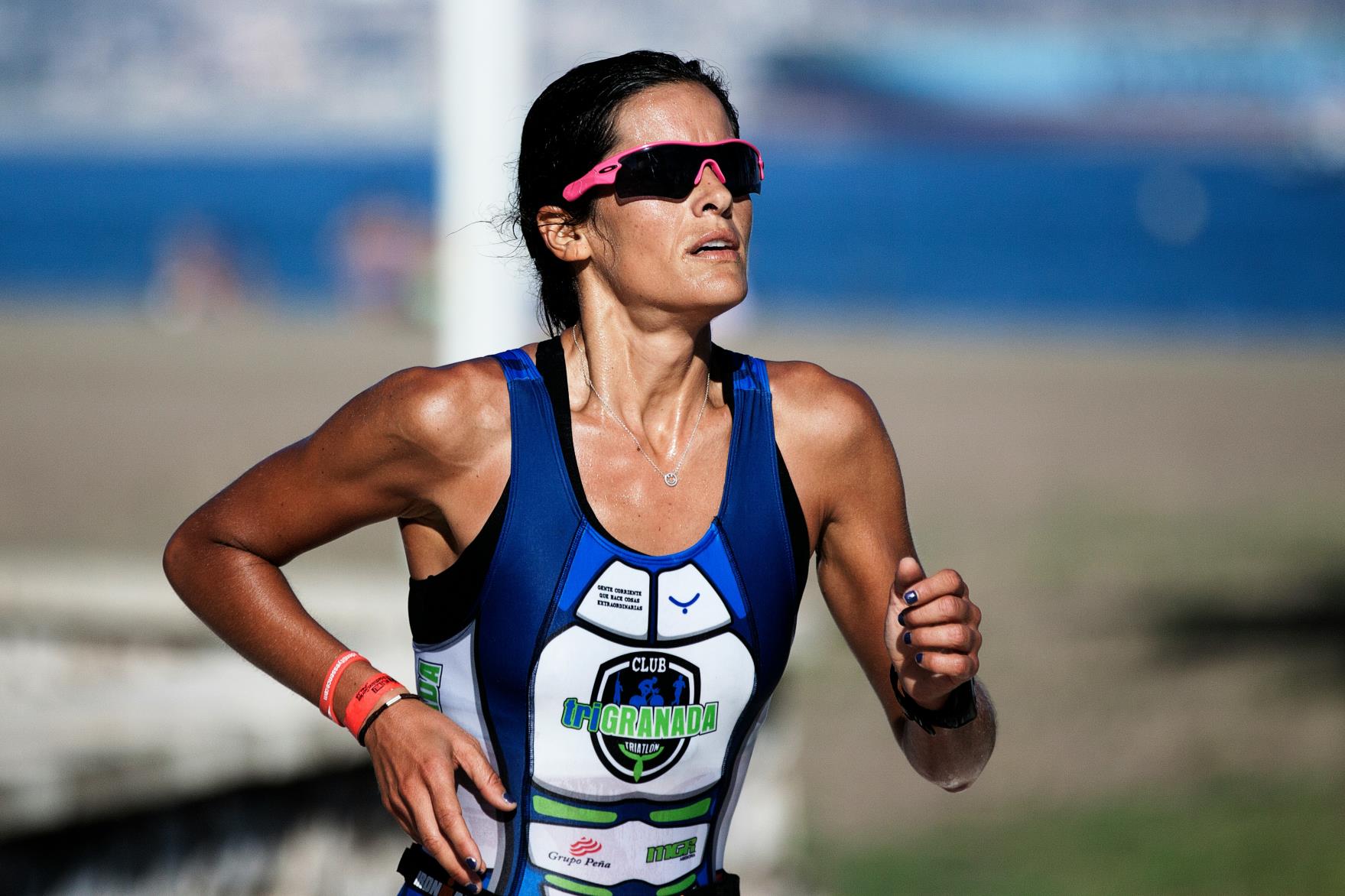
Get your FREE Guide to Running Speed and Technique
Lactate and Threshold
It's important to understand what lactate and lactic acid is and it’s not as evil as you may think!
Lactate is a molecule produced by the body during exercise when there is not enough oxygen available to the muscles. Lactic acid is the acidic form of lactate, meaning that it has an extra hydrogen ion attached to it. The terms "lactic acid" and "lactate" are often used interchangeably, but it's important for athletes to understand the difference.
During exercise, muscles produce lactate as a by-product of anaerobic metabolism. As the concentration of lactate increases, the pH of the muscle cells decreases, making the muscle more acidic. This can lead to muscle fatigue and decreased performance.
However, lactate is not entirely bad for athletes. It can be used as a fuel source by other muscles and organs in the body, and it has been shown to improve endurance performance in some athletes.
Overall, it's important for you to understand the role of lactate and lactic acid in you body and how to manage your production during exercise to optimize performance.
So, lactate is the by-product of burning fuel (glucose) in the muscles, the harder you work the higher the lactate production and the higher your heart rate.
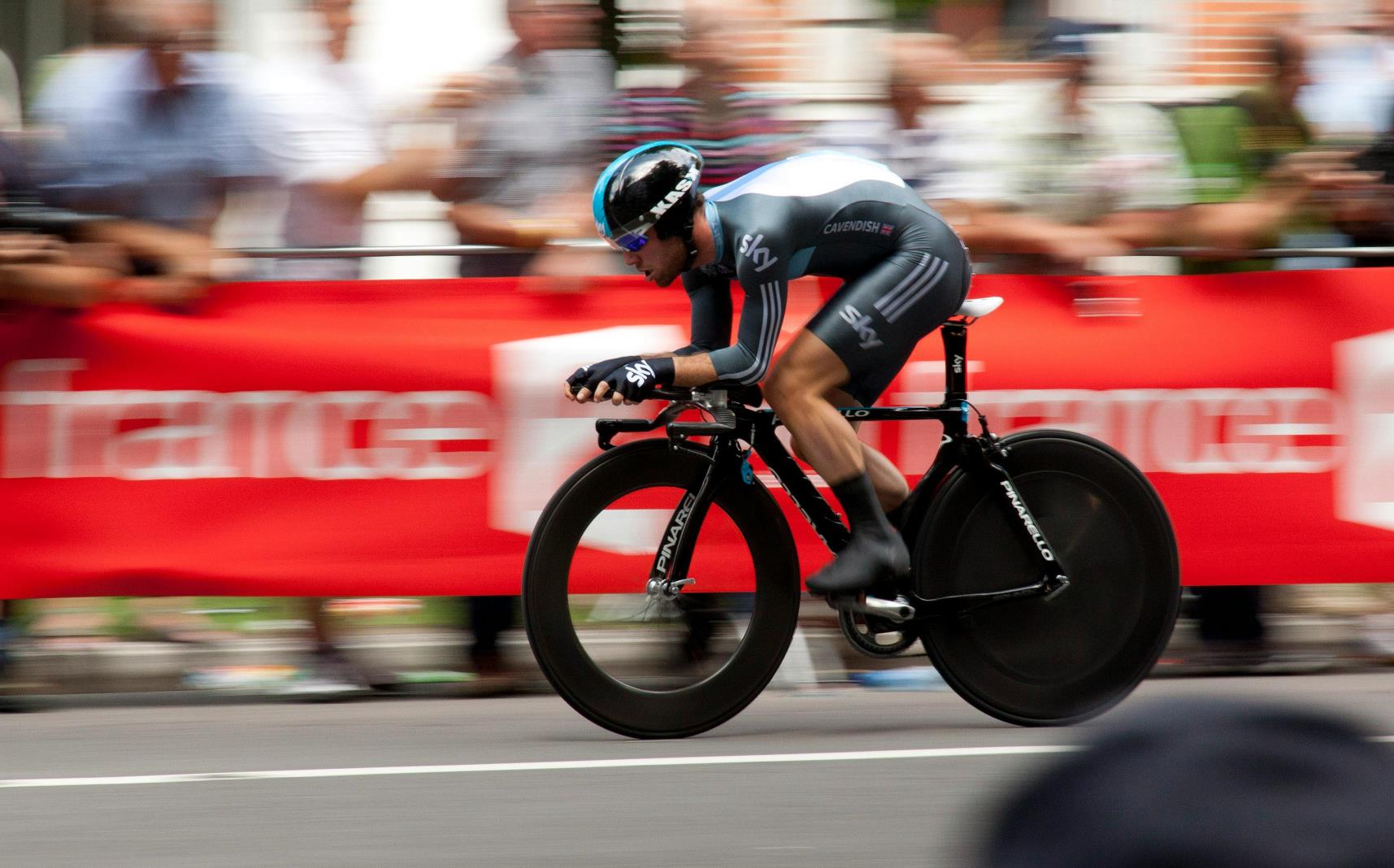
Get your FREE 31 Indoor Cycling Training Sessions and Plan
How Lactate Production related to Aerobic and Anaerobic Threshold
Aerobic and anaerobic thresholds are closely related to lactate production in the body during exercise.
The aerobic threshold, also known as the lactate threshold, is the point during exercise where lactate production begins to increase significantly. This is when your body starts to switch from primarily aerobic (with oxygen) to anaerobic (without oxygen) metabolism. At this point, lactate starts to accumulate in your muscles and blood, which can lead to muscle fatigue and decreased performance.
The anaerobic threshold is the point during exercise where lactate production exceeds the body's ability to clear it away. This is when the concentration of lactate in the blood starts to increase rapidly, leading to a build-up of lactic acid in the muscles and blood. This can cause a burning sensation in your muscles and may cause you to slow down.
Understanding your aerobic and anaerobic thresholds is important because it can help you train more effectively. By training at or near your lactate threshold, you can improve your ability to tolerate and clear lactate from your muscles and blood, leading to better performance during high-intensity exercise.
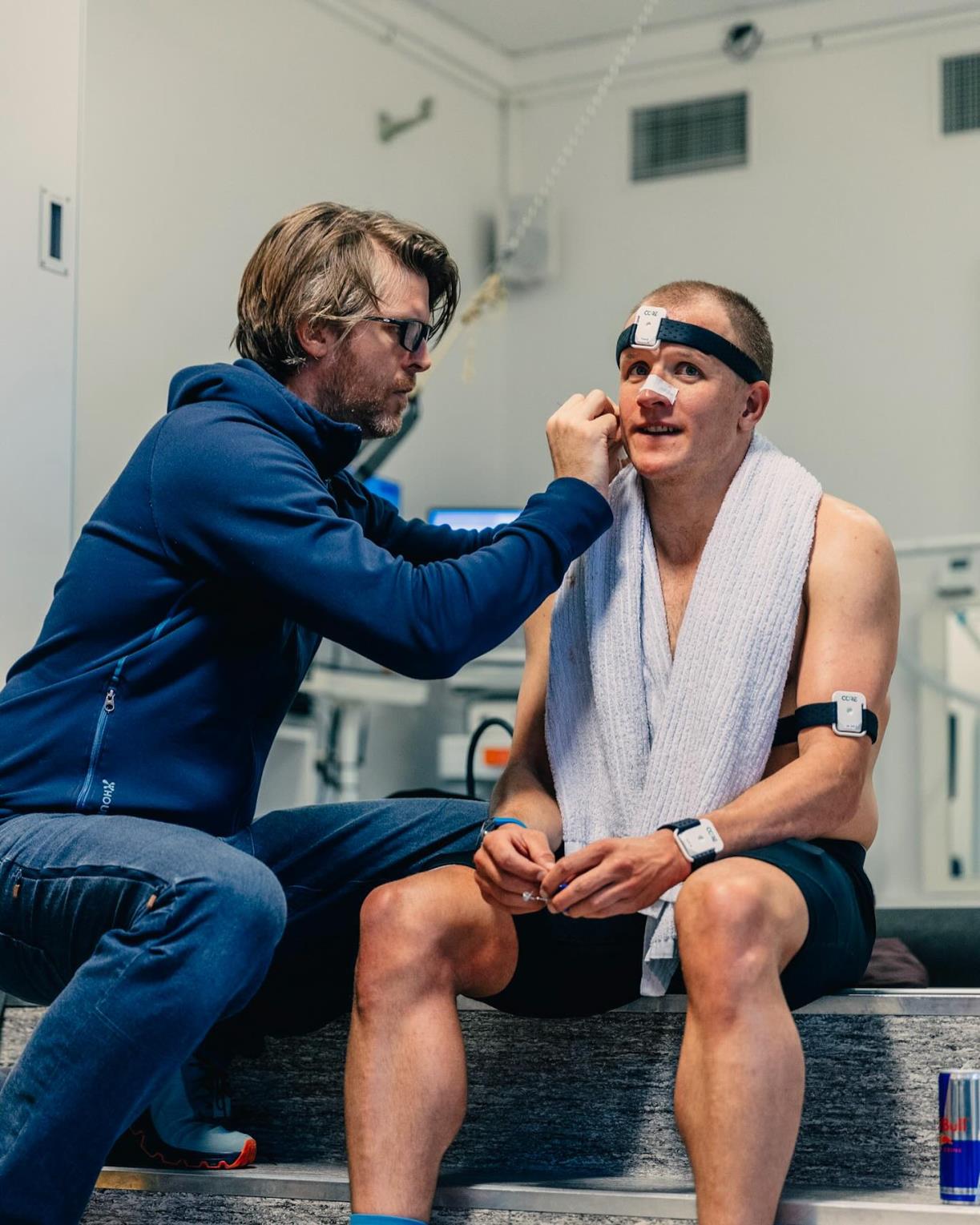
Coach Olav Aleksandr Bu taking a blood sample as part of the threshold testing protocol
Get your FREE Swimming Workouts for Triathletes E-book
Tempo or Threshold Training and VO2 Max
Have you ever heard coaches mention tempo or threshold training, but were unsure of what they meant?
To understand these concepts, it's essential to examine how lactate levels change during various exercise intensities. Lactate levels are typically measured in millimoles per litre of blood (mmol/L). At this moment in time as you sit here reading this article if I tested your blood lactate it would probably be sitting around 1 mmol/L. This would be your baseline measurement.
You may have had our blood lactate tested at some point in a lab to determine your training zones scientifically but if you have not here’s the process.
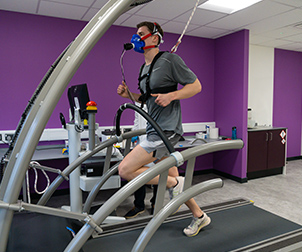
Lactate Testing at the University of Hertfordshire where I studied.
You would start the test by running on a treadmill or cycling on a stationary bike at a slow pace. Then every 4 minutes (average amount of time for your heart rate needs to reach steady state) the pace would increase by say 1km/h.
Your lactate is tested by taking a small sample of blood after every 4-minute stage, usually by pricking your finger or ear lobe. Your blood lactate would remain very similar until you reach a point where it increases significantly, we call this the 1st threshold or LT1 (see figure 1).
Your LT1 is usually around 2 mmol/L but this does vary. The test would then continue to a point where there is another significant increase in your blood lactate, we call this then 2nd threshold or LT2 (figure 1). Your LT2 is usually around 4 mmol/L but again this also varies. After this point your lactate will increase exponentially until you can’t run anymore, and you reach your VO2 max.
VO2 max, also known as maximal oxygen uptake, is the maximum amount of oxygen that you can utilize during intense exercise. It is the gold standard measure of an individual's cardiorespiratory fitness and endurance capacity. VO2 max is typically measured in millilitres of oxygen per minute per kilogram of body weight (ml/min/kg). The higher your VO2 max, the more efficient your body is at delivering oxygen to your muscles during exercise, which can lead to improved performance and endurance. Your VO2 max can be improved through regular cardiovascular exercise and training at or near your aerobic threshold.
The figure below shows a typical LT1, LT2 and VO2 Max test graph.
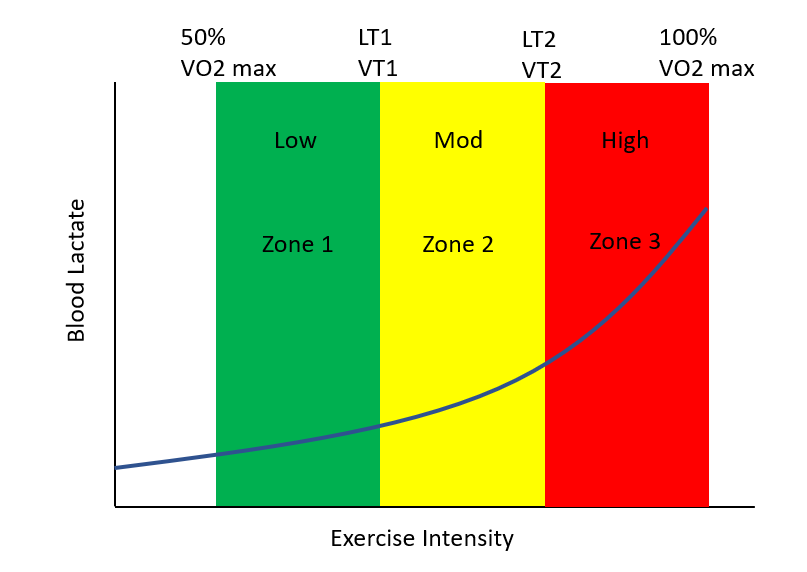
Figure 1. LT1 and LT2 turn points during exercise
How to use your LT1 and LT2 in Training
As previously discussed, exercise intensity has a direct correlation with an increase in blood lactate, and there are two points, LT1 and LT2, where lactate levels begin to significantly rise.
If you were to exercise at LT1, you could maintain that intensity for approximately 3-4 hours, with cycling usually allowing for longer durations and swimming for shorter ones.
LT1 is roughly equivalent to marathon or half ironman pace.
However, if you were to exercise at LT2, you could sustain that intensity for around 30-45 minutes, again with cycling allowing for longer durations and swimming for shorter ones.
LT2 is roughly equivalent to your 10k or sprint distance triathlon pace.
You can estimate your LT1 and LT2 by recording your heart rate during these events and calculating an average. However, this will only provide an approximation, and the most accurate method for determining your LT1 and LT2 is through a physiological lab testing.
It is worth noting that when running, your LT1 and LT2 typically occur at a heart rate that is approximately 5 beats per minute higher than when cycling.

Get your FREE Guide to Running Speed and Technique
Understanding The Language of Coaches
When coaches refer to tempo and threshold training, they usually mean LT1 and LT2.
You may have also heard coaches mention CSS (critical swim speed), FTP (functional threshold power) or rFTPw (running functional threshold power watts) these are basically different ways of describing LT2 in specific disciplines.
They are slightly different and have their own merit, but in simple terms they are the same.
So, what does all this mean and how can this relate to training?
Now that we have defined the two thresholds, we can look at how you can use them in training. This will be slightly different depending on your history of training and what your race goals are.
Having a coach to help you with this is critical to optimise your training for your individual needs. Triathlon is an endurance sport whatever the distance you race, it is therefore critical that to get faster you should increase your thresholds.
If your goal is to race at shorter distance triathlons, then your focus should be on improving your LT2 and if your goal is to compete at longer distance triathlons like Half Iron and Iron distance events you should be looking at LT1 development.
However, both LT1 and LT2 development are critical in any distance triathlon and shouldn’t be ignored.
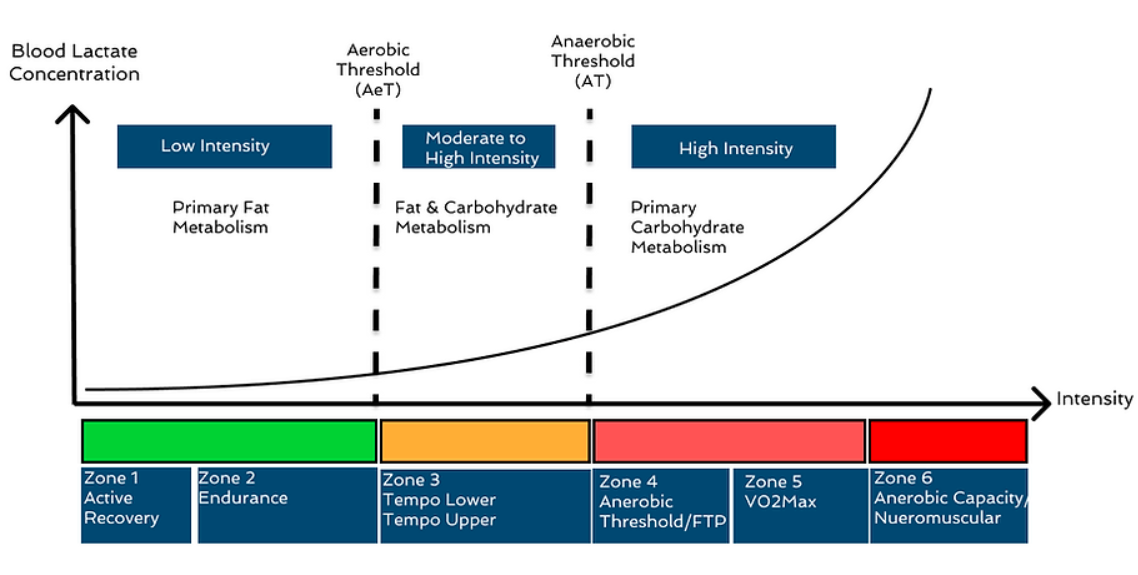
Figure 2: AeT, AT and Training Zones Source: Connecttoperform
Types of Training: Polarised, High Intensity, Threshold and High Volume
There is always a lot of discussion on how to use these thresholds to optimise performance. There are several methods but the two most popular are ‘threshold training’ and ‘polarised training’.
Threshold training loosely refers to doing most of your training in Zone 2 (see figure 1), and polarised training refers to doing 80% of your training in Zone 1 and 20% in Zone 3 or above – hence the term “80/20 Endurance training”.
A study in 2012 showed the effects of both types of training on 40k TT cycling performance (average watts). After 6 weeks of training using different training types the results showed an average of 8% increase for polarised and only just over 1% increase using the threshold training method (see table 1).
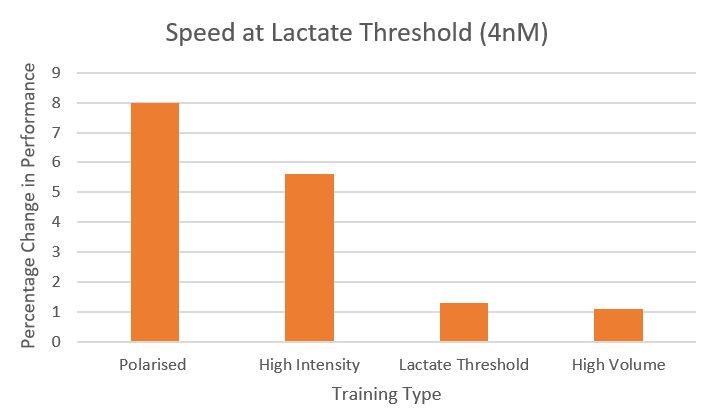
Table 1: The effect of different types of training on performance Source: Study Results
In the table above lactate threshold refers to LT2 and percentage change is the increase of average watts over a 40km TT.
The reason why you may not improve by doing a lot of your training in Zone 2 is because it’s not intense enough to properly stimulate muscular improvement but is still intense enough to produce accumulated fatigue and delayed recovery, basically you are producing lactate without the rewards.
Results from studies are never absolute but this study does throw up some interesting results which can be useful for your training.
Polarised 80/20 Training Benefits
Most coaches and elite athletes now will suggest using the polarised model of 80/20. What people can often get wrong is the thinking that all year round I should do 80% of my training really easy and 20% really hard (very polarised), this will give you improvements in the short term but will mean that you peak really quickly and then plateau.
Read more about 80/20 training and how it can optimize your training.
You can see the relative training zones in Table 2 below.
Most elite coaches and athletes will manipulate the thresholds so that most of their program is polarised but potentially isn’t as polarised as a lot of studies will suggest.
Throughout periods of the year coaches will use other models to manipulate training, and as I said before this is different depending on your race distance and training history.
There are limited studies looking into LT1 development and even in shorter distance triathlons having a good LT1 is critical. This can be still done by adopting the polarised (80/20) method; however, your so-called easy training is pushed more towards LT1.
Finding a point where you aren’t producing lots of lactate but are still working in Zone 1 is argued as the most ‘bang for your buck’ method. This method is famously adopted by the Norwegian triathletes who have been going from strength to strength in recent years.
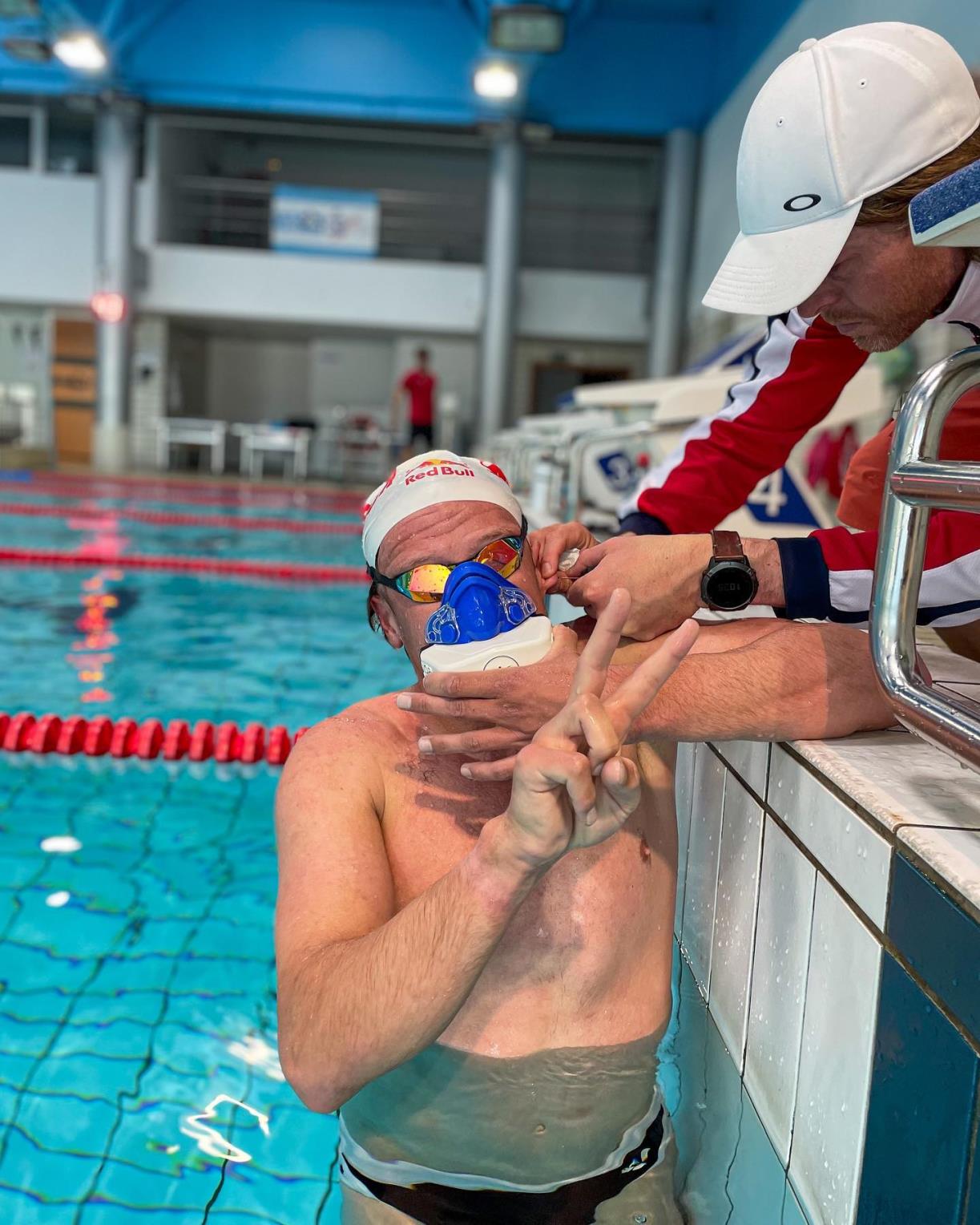
Lactate Testing Norwegian Style
A typical Norwegian triathlete running session, especially in the winter, would look at manipulating LT1 by doing under over sessions.
For example, you might do a one hour run where at points you are working slightly over LT1 and at points working slightly under LT1. They would do this once a week with minimal running above LT2 and majority of their running below LT1. Interestingly they control their zones very tightly using blood lactate testing during training. You can read more about their training methods and how you can apply it in a practical way to your training in this Blog.
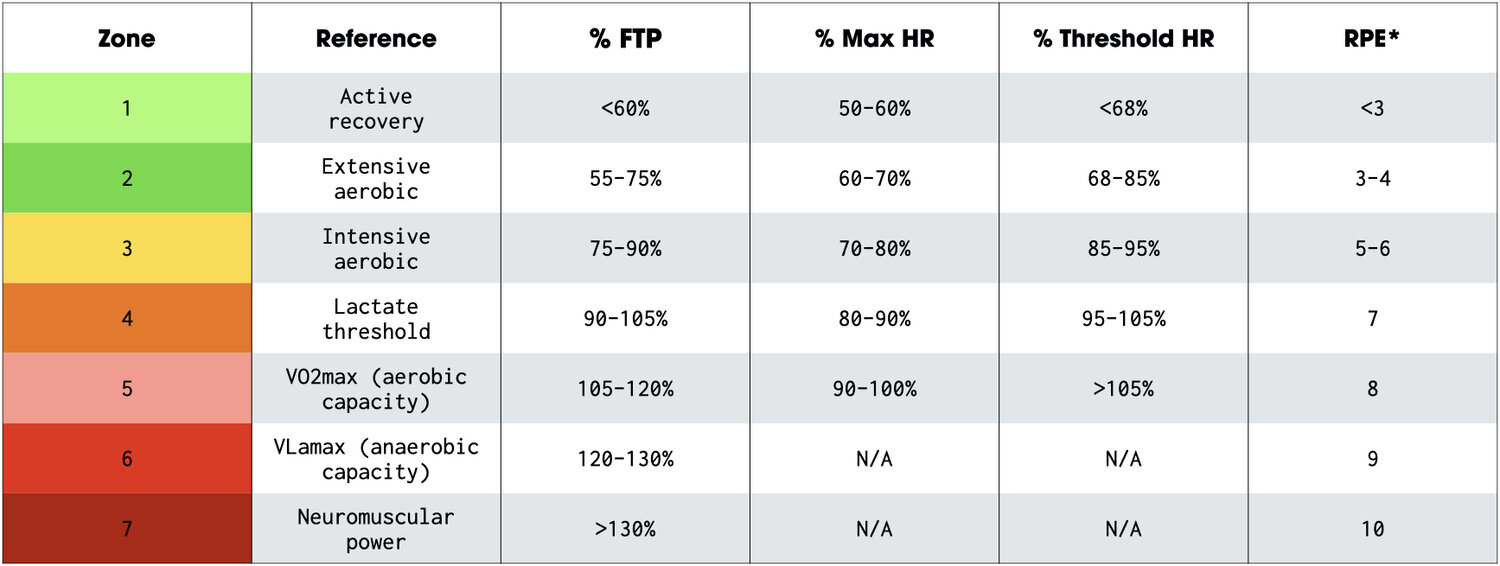
Table 2: Relative Training Zones: Heart Rate, FTP, Threshold and RPE Source: Highnorth
Conclusion: Threshold Training
Threshold training is a key component of many athletes' training programs. It involves training at or near the aerobic and anaerobic thresholds to improve your body's ability to sustain high-intensity exercise. By doing so you can improve your endurance, speed, and overall performance in triathlon as well as running, cycling, and swimming.
Understanding and knowing your own individual LT1 and LT2 (heart rate and power at each threshold) will help you understand how you can get the most out of training and how you can individualise your sessions to suit your needs and race goals.
However, it is important to approach threshold training with caution and seek professional guidance to avoid injury or overtraining. By understanding and properly implementing threshold training, you can take your performance to the next level.
Karen Parnell is a Level 3 British Triathlon and IRONMAN Certified Coach, 8020 Endurance Certified Coach, WOWSA Level 3 open water swimming coach and NASM Personal Trainer and Sports Technology Writer.
Karen is currently studying for an MSc in Sports Performance Coaching at the University of Stirling.
Need a training plan? I have plans on TrainingPeaks and FinalSurge:
I also coach a very small number of athletes one to one for all triathlon and multi-sport distances, open water swimming events and running races, email me for details and availability. Karen.parnell@chilitri.com
Get your FREE Guide to Running Speed and Technique
Get your FREE Swim Workouts for Triathletes E-book
Get your FREE Open Water Swimming Sessions E-Book
BlackBackground.png)
FAQ: Heart Rate Zones and Threshold Training
What is Threshold Heart Rate?
Threshold heart rate is the heart rate at which the body switches from primarily aerobic energy production to anaerobic energy production during exercise. This is typically the heart rate at which an individual can sustain exercise for an extended period of time, usually around 60-90 minutes, and is also referred to as the lactate threshold or anaerobic threshold. This threshold heart rate is determined by a combination of factors, including genetics, fitness level, and training status. Training at or slightly above the threshold heart rate can improve endurance performance by increasing the body's ability to tolerate and buffer lactic acid build-up.
What are LT1 and LT2?
LT1 and LT2 refer to two different lactate or anaerobic thresholds that can be used to determine an individual's fitness level and to guide training.
LT1, also known as the aerobic threshold or the first lactate threshold, is the point during exercise where the body begins to produce lactate at a faster rate than it can clear it. This is typically around 70-80% of an individual's maximum heart rate and corresponds to the transition from aerobic to anaerobic metabolism.
LT2, also known as the anaerobic threshold or the second lactate threshold, is the point at which lactate production dramatically increases, and the body can no longer clear lactate effectively. This typically occurs at around 80-90% of an individual's maximum heart rate and is often used as a marker of endurance performance.
By measuring an individual's LT1 and LT2, a coach or trainer can create a training plan that is tailored to the individual's specific needs and goals, as well as monitor progress over time.
What Heart rate zone is LT1?
LT1 heart rate zone is typically around 70-80% of an individual's maximum heart rate. It is also known as the aerobic threshold or the first lactate threshold. Training in this heart rate zone can improve aerobic endurance and help the body become more efficient at using oxygen for energy production. At this heart rate zone, the body is able to sustain exercise for a longer period of time, making it a common training zone for endurance athletes.
What is LT2 Heart rate zone?
LT2 heart rate zone is typically around 80-90% of an individual's maximum heart rate. It is also known as the anaerobic threshold or the second lactate threshold. Training in this heart rate zone can improve the body's ability to tolerate and buffer lactic acid build-up, which is important for endurance performance. At this heart rate zone, the body is operating at or near its maximal sustainable effort, making it a common training zone for endurance athletes who want to improve their speed and power output. However, training at or above LT2 can also lead to fatigue and reduced performance if sustained for too long. Therefore, it is important to have a balanced training program that includes a variety of heart rate zones to improve overall fitness and performance.
What are Heart Rate zones?
Heart rate zones are ranges of heart beats per minute (bpm) that correspond to different levels of exercise intensity. These zones can be used to help individuals train more effectively by matching their training intensity to their goals and fitness level.
How are Heart Rate zones determined?
Heart rate zones are typically determined by an individual's maximum heart rate (MHR), which is the highest heart rate that can be achieved during maximal exercise. The most common method for calculating MHR is 220 minus the individual's age. Heart rate zones can then be calculated as a percentage of MHR.
What is Threshold training?
Threshold training is a type of exercise training that focuses on improving an individual's ability to sustain high-intensity exercise for a longer period of time. This is typically done by training at or near an individual's lactate threshold, which is the point during exercise where the body switches from primarily aerobic energy production to anaerobic energy production.
What is LT1 and LT2?
LT1 and LT2 refer to two different lactate or anaerobic thresholds that can be used to determine an individual's fitness level and to guide training. LT1, also known as the aerobic threshold, is the point during exercise where the body begins to produce lactate at a faster rate than it can clear it. LT2, also known as the anaerobic threshold, is the point at which lactate production dramatically increases and the body can no longer clear lactate effectively.
What Heart Rate Zone is best for fat burning?
The best heart rate zone for fat burning is typically the low-intensity zone, which is around 60-70% of an individual's MHR. This heart rate zone is lower in intensity and relies more on fat metabolism for energy production.
Your body relies on both stored carbohydrates (in the form of glucose) and fat (in the form of adipose tissue, or fat cells) as fuel for exercise. As a low-to-moderate steady rate of exercise is maintained, glucose consumption drops as fat consumption increases.
What Heart Rate Zone is best for Endurance training?
The best heart rate zone for endurance training is typically the moderate to high-intensity zones, which include LT1 and LT2. Training in these heart rate zones can improve the body's ability to tolerate and buffer lactic acid build-up, which is important for endurance performance.
Is it necessary to train in all Heart Rate Zones?
While it is not necessary to train in all heart rate zones, a balanced training program that includes a variety of heart rate zones can improve overall fitness and performance. This can help prevent overtraining and reduce the risk of injury.
How can Heart Rate Zones be monitored during exercise?
Heart rate zones can be monitored during exercise using a heart rate monitor or a fitness tracker that measures heart rate. These devices can provide real-time feedback on an individual's heart rate and can help them stay within their desired heart rate zone during exercise.
How often should Heart Rate Zones be re-evaluated?
Heart rate zones should be re-evaluated periodically, especially as fitness level improves. This can help ensure that an individual is training at the appropriate intensity and can help them achieve their goals more effectively.
What is 80/20 training?
80/20 training is a training philosophy that involves dividing training time into 80% low-intensity training and 20% high-intensity training. This approach is designed to maximize the benefits of both low and high-intensity training while minimizing the risk of overtraining and injury. Read more about 80/20 training.
How is 80/20 training different from other training approaches?
80/20 training is different from other training approaches because it emphasizes a balance between low-intensity and high-intensity training. Other approaches may focus more heavily on one or the other, such as high-intensity interval training (HIIT) or steady-state cardio.
What is CSS training?
CSS (critical swim speed) training is a type of swim training that focuses on improving an individual's swimming endurance and speed. CSS is determined by an individual's time to swim a 400-meter time trial and is used to set training intensities for different distances and events. You can calculate your CSS here.
How is CSS training beneficial?
CSS training is beneficial because it allows individuals to train at the appropriate intensity for their current level of fitness and skill. This can improve swimming efficiency and speed, as well as reduce the risk of overtraining and injury.
What is FTP training?
FTP (functional threshold power) training is a type of cycling training that focuses on improving an individual's ability to sustain high-intensity exercise for a longer period of time. FTP is determined by an individual's power output during a 60 or 20-minute time trial and is used to set training intensities for different workouts. You can calculate your power zones based on your FTP here.
How is FTP training beneficial?
FTP training is beneficial because it allows individuals to train at the appropriate intensity for their current level of fitness and skill. This can improve cycling endurance, speed, and power output, as well as reduce the risk of overtraining and injury.
Can these training approaches be combined?
Yes, 80/20, CSS, and FTP training can be combined to create a comprehensive training program that addresses different aspects of fitness and performance. For example, an individual may use 80/20 training can be applied to overall training balance and then rFTPw can be used for running intensity, CSS for swimming intensity, and FTP for cycling target zones.
How can training intensities be determined for these approaches?
Training intensities for 80/20, CSS, and FTP training can be determined using various methods, such as heart rate monitors, power sensors, or speed via GPS smart devices. These intensities can be calculated using formulas or determined through performance testing. You can find various training calculators here.
How often should training programs be adjusted?
Training programs should be adjusted periodically, typically every 4-6 weeks, to accommodate changes in fitness level, skill, or performance goals. This can help ensure that individuals are training at the appropriate intensity and are making progress towards their goals.
What is Running with Power?
Running with power is a training method that involves measuring the amount of power you generate while running. It is similar to cycling with power, which has been popular for many years. Running with power can provide valuable insights into your running performance, such as your running economy, running efficiency, and pacing strategy.
What is rFTPw?
RFTPw stands for Running Functional Threshold Power, which is similar to the lactate threshold in running. It is the highest average power output that you can sustain for one hour of running. This measure is used to determine your power training zones, which are helpful for planning and executing a structured training plan.
How is rFTPw determined?
RFTPw is determined by a field test or a laboratory test. In a field test, you would run for one hour at the highest sustainable effort level, and the average power output for that hour would be your rFTPw. In a laboratory test, your oxygen uptake and carbon dioxide output are measured to determine your lactate threshold and rFTPw.
How can I use rFTPw to improve my running performance?
Once you have determined your rFTPw, you can use it to plan your training and improve your running performance. Your power training zones will be based on a percentage of your rFTPw, and you can target specific zones for different types of workouts, such as endurance runs, tempo runs, and interval workouts. By training in the correct zones, you can improve your running economy, efficiency, and overall performance.
Do I need special equipment to Run with Power?
Yes, you will need a power meter, which can be a foot pod, a smartwatch, or a chest strap. These devices measure the power output in watts, which can be used to calculate your rFTPw and power training zones. Some popular power meters for running include Stryd, Garmin Running Power, and Polar Vantage V2. You can get 15% of a Stryd footpod using code: COACH-PARNELL.
Is Running with Power suitable for beginners?
Running with power can be useful for runners of all levels, including beginners. However, it is recommended to focus on building a strong aerobic base before incorporating power training into your routine. This will help you improve your overall fitness and endurance, which will be beneficial when transitioning to power-based training.

Photo by Andrea Piacquadio
References
Lactate thresholds made simple - by Rob Bridges - Total Tri Training
The “Aerobic Threshold” (AeT) Explained For Cyclists — High North Performance
What is the Aerobic Threshold? (connecttoperform.ie)
#triathlon #heartrate #threshold #thresholdtraining #ironman #triathletes #triathlontrainingplans #runningtrainingplans #swimmingtrainingplans
